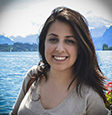On the evening of Thursday, November 28, over a hundred people with packed bags waited by the Niko Dovana Stadium in Durrës for buses to arrive to send them to Kosovo. They were the last remaining of hundreds more who had taken shelter in the stadium the night before.
Many had been spending all their time in tents with little means of getting warm, washing, or caregiving. Some were injured or had injured children, but were waiting to have a safe place to sleep before pursuing medical care. A large number of them were Roma.
As the hours passed and the buses didn’t arrive, people became increasingly distrustful that they would ever come.
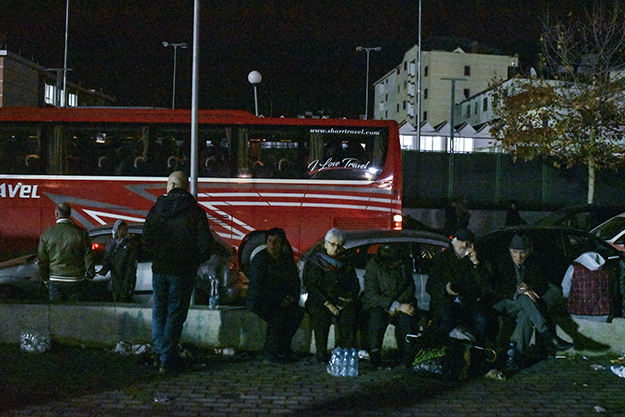
Thousands of people were evacuated from Durrës and nearby villages in the days following the 6.4 magnitude earthquake that struck in the early hours of November 26. Photo: Arianit Ramiqi / K2.0.
Around 6 p.m., two buses drove by the stadium and entered the Leonik Tomeo School, which had become a main distribution point for aid coming in from abroad. Confusion and chaos ensued as people crowded around the buses hoping this would be their chance to leave. Slowly, news emerged that the buses were not there to transport people, but to bring more volunteers.
An exasperated man exclaimed: “What more will they [volunteers] do? We need shelter!”
This sentiment resonated with what many displaced people in Durrës, Thumanë, and nearby villages were expressing in the days following the powerful 6.4 magnitude earthquake that hit western Albania early Tuesday morning.
Though thankful for the food and clothing they’d received from donors around Europe and further afield, those displaced by the earthquake continued to lack answers about the fate of their homes — for most, their life’s fortune — or any promise of adequate shelter. The urgency and panic that precipitated from the disaster had begun to dissolve into a sense of hopelessness as many began to realize that this could be their new normal.
Many of those who have been worst hit by the earthquake and its aftermath were already amongst the most vulnerable.
Liri Kuçi, an activist with Organizata Politike, a grassroots political organization that has been heavily involved in earthquake response efforts, argues that the earthquake has brought to light a number of societal issues, both in terms of the immediate response and longer term structural problems.
She gives the example of Roma and Egyptian families, many of whom, she says, have faced discrimination at the hands of both other citizens and the state, with reports that some institutions have told them they have too many children and there is not enough bedding and covers for everyone.
“Members of this community have claimed that they are being treated unfairly in the shelters as well as in the queue for those travelling to Kosovo, because their cases are represented as abusive of resources and not treated with the same gravity as those of their white fellow citizens,” she says.
Kuçi also argues that the earthquake has exposed a slew of crimes that have been committed against the poor and marginalized over the last decades, particularly with regard to the lack of building construction regulations.
“In the end, the victims and sufferers remain the poor citizens who have invested and worked throughout their lives to build a safe home,” she says. “It is the poor population who, because of economic incapacity, have had to settle for poorly built or bought housing. [They] have been the most affected by this earthquake, not to mention marginalized and discriminated groups … who face constant food, employment, life and housing insecurity.”
Villages missing shelter
In the village of Mazhë e Vogël near Thumanë, Ibrahim and Sybe Dema spend their days and nights in a shed in their front yard, where they and their family have taken shelter since the night their house was damaged by the earthquake. Like many other villagers, they are afraid to leave their home for fear of looting.
The only contact they have had with state officials since the earthquake was two days before K2.0 met them, when engineers came to assess their home as uninhabitable and advise them not to go inside. They say they were not given any answers about what could be done for their home, nor any temporary solutions.
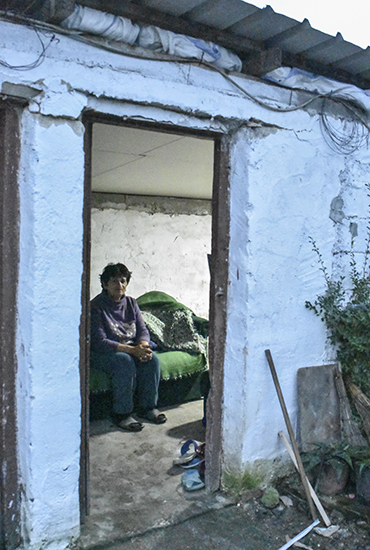
Sybe Dema and her husband have been sleeping in a shed in their front yard since the earthquake. Photo: Arianit Ramiqi / K2.0.
The Demas’ sheltering situation remains slightly better than that of many villagers in the area who have chosen to stay near their homes. With nowhere else to take shelter, many have slept outside or in makeshift tents. Aid distribution has been concentrated in the towns and cities most affected, making it harder for those in more rural areas to get access to what they need most of all — tents.
Ibrahim, who lost his arm during a work accident 25 years ago, considers the destruction of his home the second great tragedy of his life, and feels close to losing hope entirely.
“The state has gone to sleep,” he says. “Come here and at least give condolences for the situation I’m in. I’m a human too, I’m stressed, I feel alone.”
Caregiving challenges
Forty kilometers away in Durrës, dozens of people wait by the Leonik Tomeo school gates for resources and food to be offered through the bars — it’s 72 hours after the main earthquake when K2.0 is here, but many of those with nobody else to turn to are still waiting for basic provisions. Several complain of being left outside of the distribution center with nothing to do but stare at the mountain of aid that has piled up and is beyond their reach.
Mothers and other caregivers of young children face a unique burden in temporary shelters.
Marsida and her friend have been waiting outside Leonik Tomeo since the early morning, having left the nearby school they had taken shelter in because they worried for their children’s lives after another strong aftershock shook the building.
Marsida’s apartment was destroyed during the earthquake and she has been sleeping in temporary shelters with her young children since. “The landlord told me that the building has been deemed uninhabitable and that he can’t do anything about it, so now I’m left here,” she says.
She is one of many mothers, particularly of younger children, who voice concerns about the distribution of materials and sanitary conditions in the shelters. Diapers are hard to come by — several women say that when they have found diapers, they have been given much less than what their babies need.
“Look — they gave me six diapers and told me that this should last me for two days,” she says. “Babies soil at least five diapers a day. How is that enough?”
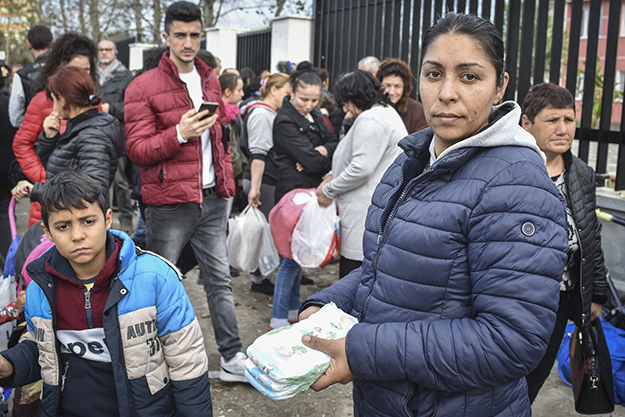
Marsida and other women have complained that they have not been given enough diapers and other essential items required for taking care of their children. Photo: Lorina Hoxha / K2.0.
While food is widely available, much of it lacks any nutritious value. In the shelter camps set up in Thumanë, several people report that they have been handed expired food. Simple salami sandwiches were the only kinds of food seen distributed on Friday morning and afternoon from the Leonik Tomeo school distribution point.
As people crowd around for more sandwiches being handed out by volunteers through the school’s gates, Marsida’s friend flips open the cover of her stroller to show the face of her baby.
“Look at what they’re distributing. Just bread and sandwiches,” she says. “Do you think this baby can eat bread? She hasn’t even grown teeth! What am I supposed to feed my baby?”
At the nearby Benardina Qerraxhia school, which has also been turned into a temporary shelter, more women bemoan the lack of facilities for keeping themselves and their kids clean. One woman says she went back to her destroyed home the evening before to wash herself and her three children because she could no longer stand feeling so dirty.
She lifts her baby son from his stroller to show that he has wet himself again, and explains that she has just three diapers to last her several days.
Lacking building standards
The fact that Albania suffered such a large earthquake should not have come as a huge surprise.
Seismologists point out that Albania’s vulnerable position between the Eurasian and African tectonic plates means it is likely to experience several major earthquakes within a century. The last earthquake over 6.0 occured in 1979 close to Albania’s border with Montenegro, leaving 136 dead.
Following the 6.4 magnitude earthquake early Tuesday morning, hundreds of aftershocks have been felt, and they continue more than a week later.
The strongest occurred less than four hours later at a magnitude of 5.4, but Stephen Hicks, a seismologist at Imperial College London, says it is unlikely for an aftershock to be any stronger and that the frequency of aftershocks should also quickly decrease over time.
“Whatever the probability of an aftershock is on the first day, the second day will have 1/2 the probability of the first day and the 10th day will have approximately 1/10 the probability of the first day,” he says.

Thousands of buildings were severely damaged or destroyed in the earthquake on November 26, while aftershocks still continue. Photo: Arianit Ramiqi / K2.0.
However, even as earthquakes grow less frequent, aftershocks over 5.0 may still be detected months from now. Hicks emphasizes that the time and location of impending earthquakes cannot be predicted, nor is it likely that the frequency of major earthquakes in the region will change.
With thousands of buildings having already been completely destroyed or severely damaged throughout Albania, and aftershocks set to continue, experts say that assessing the structural integrity of other buildings is imperative.
Luljeta Bozo, an engineering professor at the University of Tirana, noted in a recent interview for A2: “A minimum cultural understanding that we need to have is that we live on land that will shake every now and then.”
For Bozo, this means that every proposed building that is intended to last a hundred years should factor in two, if not three major earthquakes.
In the days following the earthquake, the issue of Albania’s unregulated construction industry has moved to the fore of public discussion as the 51 tragic deaths have begun to gain context.
While many have now become familiar with standard earthquake response procedures, typical recommendations like “drop, cover, and hold on” are contingent on living in a building that is not susceptible to collapse, something that few had any guarantee of last Tuesday morning.
Ultimately, only so much is in the hands of regular people: “We [seismologists] often say the phrase: “Earthquakes don’t kill people. Buildings do,” Hicks explains.
Bozo emphasized that there wouldn’t have been nearly as much damage if the buildings affected had been constructed according to proper regulations and by qualified people.
“There are two things that led to this collapse,” she said. “For one, people didn’t know where to build, and so they built on weak terrain. For example, you should not build on the marsh of Durrës. This used to be categorically prohibited. Yet the marsh of Durrës has now become a city, and there is no guarantee of the safety of those buildings.”
Bozo further noted that seismic microzoning studies had been conducted on every city in Albania and were available, though they had not been made use of by those managing construction in the country since the fall of communism at the start of the 1990s. These studies specifically warned against building on the coast of Durrës, where several hotels have now collapsed.
“The second thing is that the construction has not been done by qualified people,” she said. “The most elementary rules for having a stable building have been violated … We keep saying we’re using the EuroCode — these are empty words. The EuroCode has no legal force, and this makes oversight impossibly difficult.”
The current situation sharply contrasts with building regulations prior to Albania’s transition. For Bozo, it is the government’s responsibility not only to assess and classify the state of every building after the earthquake, but to reintroduce strong building regulations such that hazardous height additions or ground floor conversions can no longer be legalized.
“We have no control over how these projects are realized. There is none whatsoever,” Bozo said, in an interview for Ora News. “It’s been 25 years of building without any rules.”
Prime Minister Edi Rama has tried to present a tough stance on unregulated construction in recent days, saying that, “Those who built [these damaged buildings] better repair them or go to prison.” Some initial steps have also been taken to investigate building violations with the aim of prosecuting those responsible.
But Organizata Politike’s Kuçi points out that this is too late for those who lost their lives in Tuesday’s quake.
“More than victims of a natural disaster, the 51 people who lost their lives during the earthquake are a testament to the disorder of construction permits in the country, highlighting local and central government partnerships with businesses and large building owners without criterion,” she says. “It took an earthquake of such magnitude to finally seriously discuss the crime we have committed on our coast in Albania.”
Residents left in limbo
Several locals in Durrës report that the newer buildings in their neighborhood had extra floors added without permits.
Pointing to an 11-story building that was entirely slanted, a baker, who preferred not to be named, says that the building only had a permit for seven floors, but additional floors were added with no regard as to whether the foundations could support them.
At Lagja 18, several destroyed apartment buildings are surrounded with tape marking them as uninhabitable. Dozens of people can be seen sitting by the sidewalk outside of their homes with their belongings and some furniture, waiting to transport themselves to the home of a family member or wherever else they have found shelter.
Two young men are running up and down moving furniture from their home in a building that is noticeably more damaged than the rest.
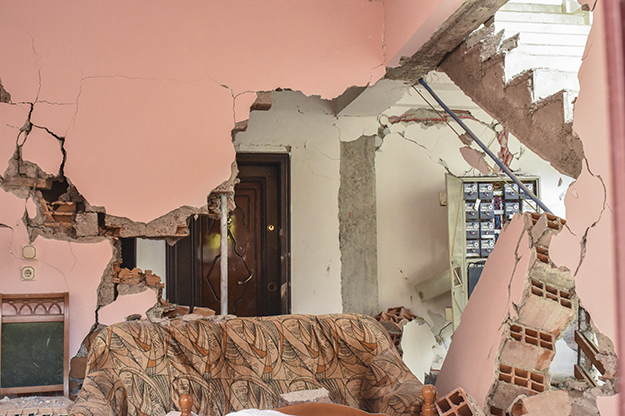
Several buildings in Durrës’ Lagja 18 have been deemed uninhabitable. Photo: Lorina Hoxha / K2.0.
“How far would you say that building over there is from this one?” they ask, pointing to a nearby building. “Maybe 40 meters. And yet, look at how that one looks compared to this one. They laid the ground on that one, but they never did here. The state forgot about us a long time ago.”
Another man sitting with his furniture in the front yard of the same building says city officials didn’t give them any information when they came to register their building as uninhabitable. They say they went to the Municipality to ask about the possibility of being rehoused elsewhere, and the Municipality told them to go to the County office.
“The [County] — closed. There’s no one there, it’s a holiday,” he says. “That’s that: Neighborhoods are destroyed and the [County] office is closed.”
Sonila Kapllani lived in an older 5-story apartment building with her husband and two daughters, who she has sent to Berat to live with her parents. Her and her husband have been sleeping in their car since last Tuesday.
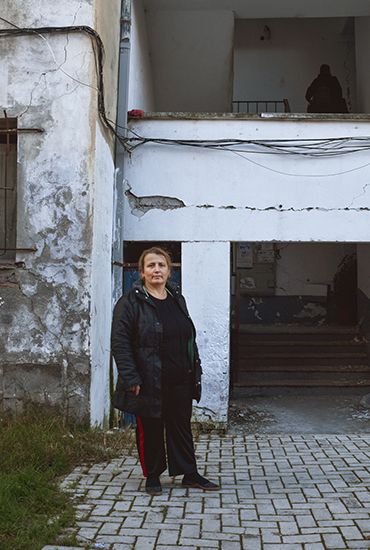
Sonila Kapllani’s apartment building has been deemed uninhabitable, but she says she can’t leave the area for fear she then wouldn’t receive any required support for dealing with her property from local authorities. Photo: Lorina Hoxha / K2.0.
Kapllani explains that she reported large cracks and worrisome damage to her apartment after a 5.6 magnitude earthquake on September 21 this year.
“We went and signed up at the [municipal] office to have our house inspected. They never came, even though they said they would,” she says. “Eventually I just filled in the cracks myself. I had actually just finished when this next one hit.”
Kapllani and her husband say that after the recent earthquake, engineers came by and carried out a preliminary assessment of their apartment and deemed it uninhabitable, but that they have not been given any viable solutions.
“They told us to go to Kosovo. I can’t go to Kosovo, because I can’t leave my home like this,” she says. “We’re staying here waiting for engineers. One of the police officers told me that they only deal with the people that are still here, that the ones that are gone can figure it out themselves.”
The Municipality of Durrës has said that in addition to prioritizing the provision of shelter for those affected, they are focused on building inspections and destroying the buildings that cannot be repaired. Only after this process is done will the work of rebuilding begin.
Walking through Durrës’ neighborhoods, it is impossible not to wonder why some buildings fared so much worse than others. For rural homeowners and urban tenants alike, the earthquake stripped them of their most basic source of security.
A few days after the quake, K2.0 encountered an older resident of the city that was among the few remaining in its deserted streets. Looking up at a recently constructed highrise that had partially collapsed, the resident could only call Tuesday’s events “a massacre.”K
Feature image: Lorina Hoxha / K2.0.







